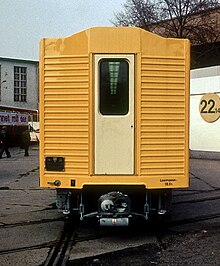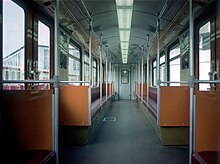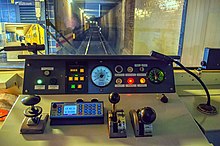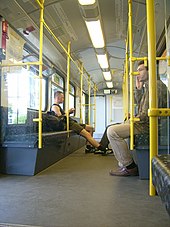BVG series G
| U-Bahn Berlin small profile series G |
|
|---|---|
|
GI / 1E train 1083 on September 19, 2010 at Bombardier's Hennigsdorf plant
|
|
| Numbering: | see below |
| Number: | 123 double railcars |
| Manufacturer: | LEW |
| Year of construction (s): | 1974-1989 |
| Axis formula : | B'B '+ B'B' |
| Gauge : | 1435 mm ( standard gauge ) |
| Length over coupling: | 12,830 mm |
| Height: | 3190 mm |
| Width: | 2260 mm |
| Trunnion Distance: | 7570 mm |
| Bogie axle base: | 1850 mm |
| Empty mass: | 37.0 t (GI / 1) |
| Payload: | 54.4 t (GI / 1) |
| Top speed: | 70 km / h (throttled to 62 km / h) |
| Hourly output : | 480 kW |
| Acceleration: | 1.15 m / s² |
| Braking delay: | 1.15 m / s² (electrical) 1.50 m / s² (pneumatic) |
| Wheel diameter: | 820 mm |
| Power system : | 750 V = |
| Power transmission: | lateral busbar coated from above |
| Number of traction motors: | 4th |
| Drive: | Two-axle longitudinal drive |
| Control: | Contactor control |
| Coupling type: | Scharfenberg coupling |
| Seats: | 66 |
| Standing room: | 133 |
| Floor height: | 1010 mm |
The G series of the Berliner Verkehrsbetriebe is the only vehicle series designed in the GDR for the small-profile network of the Berlin subway . The vehicles are used today on lines U1 and U2 (before December 2015 almost exclusively on the U2).
development
Gisela and Gustav
While the EIII cars were built for the large-profile line E (today's U5 ) from converted vehicles from the Berlin S-Bahn , the trains of the pre-war series AI and AII still ran on line A (today's U2) . At almost 70 years of age, the cars had already reached the limits of their service life in the early 1970s.
The problem with the procurement of new vehicles was that both the conversion of former S-Bahn wagons of the 275 series and the delivery of metro wagon machine wagons according to Soviet standards were out of the question, as the narrow clearance profile of the small-profile network did not allow this. That is why the transport companies had to commission the construction of their own series. In 1974 the LEW "Hans Beimler" in Hennigsdorf were commissioned to build the vehicles. In 1975 the LEW delivered the G series prototype train . Based on its code letters, the prototype was named Gustav . The unit was then delivered to BVB, extensively tested and presented to the public at the 1975 Leipzig spring fair.
As with the West Berlin A3 series , all the wheelsets of all the cars in one unit were driven. The rest of the box body of the double railcars was based on the railcar-sidecar principle: one railcar had a driver's cab at one end, the other railcar had none. As a result, the smallest unit that could be used in passenger transport was a four-car train.
The prototype revealed numerous problems on the first laps on line A. The designers then worked on an improved version that should be ready for series production. The prototype Gustav was parked in 1979, later electrically adapted to the series GI type, retired in 1993 and finally scrapped in 1997.
The result of the revision was the significantly improved GI series with the nickname Gisela . Visually, the series vehicles differ from the Gustav mainly through the characteristic fronts: in the prototype, the arrangement of the lamps from the EIII type was adopted, in the series vehicles the headlights and tail lights are arranged side by side in a common housing. In addition, the side windows have been increased in height and the front wall windows in height and width. Deliveries began in 1978. There was a requirement to replace all old construction vehicles of the AI and AII series with new construction vehicles by 1984, which was also necessary in view of the age of the pre-war vehicles.
In 1983, however, ten double multiple units had to be delivered ex works to the Piraeus – Athens – Kifissa suburban railway due to export obligations . Since a larger profile was used here, compensating bulges, also jokingly called "flower boards", were attached to the car bodies to bridge the gap between the train and the platform edge. In addition, the car bodies were set higher. The vehicles were given the designation GII, came back to East Berlin from 1985 and were added to the GI series after the modifications for Athens had been dismantled. They were replaced in Athens by vehicles also manufactured by the LEW but developed by MAN, which were based on the G-trains. After their predecessors GII, they were given the designation GIII , but the vehicles were never used in Germany. Since the export of the GIII brought foreign currency to the GDR, the order had absolute priority over the replacement of the AI and AII and so the deadline for the decommissioning of the old AI and AII series, which was scheduled for 1984, could not be met.
After the order for Athens was completed, the LEW produced another technically improved version of the GI series from 1986, which was named GI / 1. The delivery of these cars was completed in 1989. On November 5th of this year the last cars of the series AI and AII were parked. At that time, the oldest vehicles were already over 80 years old.
After reunification
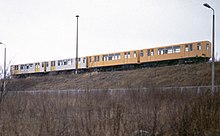
At the turn of the century , 119 double multiple units were in use. For the small profile line A (from 1990 U2) this number was completely sufficient, there were even several vehicles in excess. This was justified by the fact that a sufficiently large reserve would be available in an emergency; In 1972, for example, there was a tunnel fire at the Alexanderplatz subway station , in which 14 parked subway cars burned out completely.
The vehicles were initially still used on the U2, later occasionally on the former U15 line (today's U1 ). However, one quickly noticed the first defects in the vehicles, which often simply stopped. The BVG already wanted to part with the vehicles and commissioned the production of the A3L.92 series , which, however, could not have completely replaced the vehicle fleet . A buyer was quickly found for the vehicles that had become surplus, the Pyongyang subway . In addition to 60 double railcars of the GI series (including ten former GII from Athens), the North Korean capital 's subway also took over 108 double multiple units of the D series , which were last used on the U5. The vehicles were shipped via Wismar to their place of use and, again provided with "flower boards", adapted to local conditions. In 2001, all GI vehicles in Pyongyang were converted for a S-Bahn-like operation. This included the construction of a hoop pantograph and a converter that adjusts the voltage for the GI trains. The coupled railcars are fed with 750 volts direct current via a train busbar. The vehicles there mostly run in four-car trains. In order to be able to use the cars universally, some motor coaches without driver's cab were equipped with additional driver's cabs.
In 1997 the BVG upgraded the first GI / 1, they were provided with loudspeaker announcements, the seat cushions made of synthetic leather were replaced with vandal-resistant ones, the door handles were replaced by door knobs and prepared for the train driver self-handling operation (ZSA). The original top speed was also reduced from 70 to 62 km / h.
On July 8, 2000, during the Love Parade , a fire broke out in the Deutsche Oper underground station , in which a GI train burned out. The BVG then parked all of the cars in the series until December 2001, as the cause of the fire was obviously in the vehicle. The wagons were upgraded again before returning to regular service.
In 2004, the BVG decided to upgrade the remaining wagons again. The vehicles were optically adapted to the BVG corporate design and equipped with a multi-purpose compartment for prams or wheelchair users. In addition, two two-car units were permanently coupled together, making a four-car train the smallest operational unit. Since this pattern is similar to that of the HK series , a corresponding numbering was also made. It is interesting that the almost 20-year-old vehicles were "modernized" by installing almost 40-year-old components (including driving switch units) from parked DL vehicles. The first two vehicles were presented to the public on October 25, 2005 at a festive roll-out.
Since the 2015/2016 timetable change, which came into force on December 13, 2015, trains of the series have also been running on the U1; previously they were almost exclusively (with a few exceptions, e.g. the U12) in use on the U2.
Wagon construction
| Type | Delivery year | Athens | BVB | BVG |
|---|---|---|---|---|
| G | 1974 | 135 750-135 756 135 751-135 757 |
499-493 498-492 |
|
| GI | 1978 | 135 758-135 772 135 759-135 773 |
491-477 490-476 |
|
| 1979 | 135 774-135 778 135 775-135 779 |
475-471 474-470 |
||
| 1979 | 135 782-135 794 135 783-135 795 |
469-457 468-456 |
||
| 1980 | 135 796-135 832 135 797-135 833 |
455-419 454-418 |
||
| 1980 | 135 836 135 837 |
417 416 |
||
| 1981 | 135 838-135 852 135 839-135 853 |
415-401 414-400 |
||
| 1982 | 135 854-135 856 135 855-135 857 |
399-397 398-396 |
||
| 1983 | 135 858-135 862 135 859-135 863 |
395-391 394-390 |
||
| GII | 1983 | 102 202 |
135 866 135 867 |
389 388 |
| 1983 | 104-107 204-207 |
135 870-135 876 135 871-135 877 |
387-381 386-380 |
|
| 1983 | 108 201 |
135 878 135 879 |
379 378 |
|
| 1983 | 109-112 209-212 |
135 880-135 886 135 881-135 887 |
377-371 376-370 |
|
| GI / 1 | 1987 | 135 896-135 898 135 897-135 899 |
369-367 368-366 |
|
| 1988 | 135 900-135 938 135 901-135 939 |
365-327 364-326 |
||
| 1989 | 135 940-135 998 135 941-135 999 |
325-267 324-266 |
A double railcar of the GI / 1 series consists of two four-axle railcars closely coupled to one another. The car bodies were made of lightweight aluminum using extruded profiles. Beaded aluminum sheets were used for the side panels, which give the vehicle its characteristic features.
Only one driver's cab was provided for each double multiple unit, therefore the distinction between GIa and GIb follows. A second driver's cab was not planned because four-car trains were supposed to form the smallest units in regular operation. The cab-free end walls are provided with wicket doors, as there are places in the network where cars cannot be exited through the side doors. The wicket doors are closed on the inside with triangular edges typical of the underground.
In terms of vehicle dimensions, the G-wagons are closely based on those of the AI and AII, also only two doors per car and side are provided, which have a clear width of 1200 millimeters to compensate for the missing third door. These are compressed air operated double sliding doors . When delivered, they were equipped with mechanical locks that were also used on the double-decker single cars delivered at the same time and the prototypes of the 270 series S-Bahn multiple units . They were opened by hand and could be closed centrally by the driver.
The switchgear of the vehicles operated via contactors has a total of 23 driving and 22 braking levels. A longitudinal motor is built into each bogie and drives both wheel sets via two hollow shaft gears. The bogies are welded steel constructions, the wheel sets run in roller bearings. The bogie frame is supported by metal-rubber springs (Megi springs) on the axle bearings. The end bogies of a double railcar have pantographs on both sides.
The unit is braked by a self-excited resistance brake; in addition, the trolleys have a pneumatic disc brake that acts on all axles and a spring-loaded brake as a parking brake .
Delivery series
Together with the prototypes, a total of 123 G series double multiple units left the factory in Hennigsdorf. In addition to Berlin, some of these cars were also used in Athens and later in Pyongyang . The adjacent table is intended to give an overview of the cars and their numbering.
For a better overview, the a- and b-cars are separated from each other, the first line shows the numbering of the b-car, the second that of the a-car.
literature
- Hans-Joachim Hütter: The subway cars of the type GI . In: Verkehrsgeschichtliche Blätter . No. 5, 1979.
Web links
Individual evidence
- ↑ Printed matter 18/13782. (PDF) Berlin House of Representatives, April 3, 2018, accessed on April 19, 2018 .


